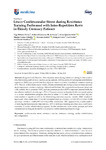Mostrar o rexistro simple do ítem
Lower Cardiovascular Stress during Resistance Training Performed with Inter-Repetition Rests in Elderly Coronary Patients
| dc.contributor.author | Ribeiro-Torres, Olga | |
| dc.contributor.author | Sousa, Arilson Fernandes M. de | |
| dc.contributor.author | Iglesias-Soler, Eliseo | |
| dc.contributor.author | Fontes-Villalba, Maelán | |
| dc.contributor.author | Zouhal, Hassane | |
| dc.contributor.author | Carré, François | |
| dc.contributor.author | Foster, Carl | |
| dc.contributor.author | Boullosa, Daniel | |
| dc.date.accessioned | 2020-06-12T14:37:32Z | |
| dc.date.available | 2020-06-12T14:37:32Z | |
| dc.date.issued | 2020-05-28 | |
| dc.identifier.citation | Ribeiro-Torres, O.; de Sousa, A.F.M.; Iglesias-Soler, E.; Fontes-Villalba, M.; Zouhal, H.; Carré, F.; Foster, C.; Boullosa, D. Lower Cardiovascular Stress during Resistance Training Performed with Inter-Repetition Rests in Elderly Coronary Patients. Medicina 2020, 56, 264. https://doi.org/10.3390/medicina56060264 | |
| dc.identifier.issn | 1010-660X | |
| dc.identifier.uri | http://hdl.handle.net/2183/25708 | |
| dc.description.abstract | [Abstract] Background and Objectives: Hemodynamic stress during resistance training is often a reason why this training method is not used in cardiac patients. A lifting protocol that imposes rests between repetitions (IRRT) may provide less hemodynamic stress compared to traditional resistance training (TT). The aim of this study was to verify di_erences between set configurations on hemodynamic stress responses in resistance training. Materials and Methods: We compared hemodynamic (heart rate (HR), systolic blood pressure (SBP), and rate pressure product (RPP)) responses assessed with the auscultatory method in elderly (age = 75.3 _ 7.3 years) coronary male patients who were participating in a cardiac rehabilitation program allocated to either TT or IRRT with the same load (kg) and total number of repetitions (24) in the bilateral leg extension exercise. Results: IRRT resulted in significant lower values than TT for RPP at repetitions 8 (p = 0.024; G = 0.329; 95% CI: 0.061, 0.598) and 16 (p = 0.014; G = 0.483; 95% CI: 0.112, 0.854). Conclusions: IRRT appears to be a viable method of reducing the hemodynamic response (i.e., RPP) to resistance training and, thus, may contribute to the safety of cardiac rehabilitation programs. Further studies with more cardiac patients and other measurement techniques should be conducted to confirm these important findings. | es_ES |
| dc.language.iso | eng | es_ES |
| dc.publisher | MDPI AG | es_ES |
| dc.relation.uri | https://doi.org/10.3390/medicina56060264 | es_ES |
| dc.rights.uri | http://creativecommons.org/licenses/by/4.0/ | * |
| dc.subject | Cardiovascular stress | es_ES |
| dc.subject | Resistance exercise | es_ES |
| dc.subject | Resistance training | es_ES |
| dc.subject | Cardiac rehabilitation | es_ES |
| dc.subject | Set configuration | es_ES |
| dc.subject | Estrés cardiovascular | es_ES |
| dc.subject | Ejercicios de resistencia | es_ES |
| dc.subject | Entrenamiento de resistencia | es_ES |
| dc.subject | Rehabilitación cardíaca | es_ES |
| dc.title | Lower Cardiovascular Stress during Resistance Training Performed with Inter-Repetition Rests in Elderly Coronary Patients | |
| dc.type | info:eu-repo/semantics/article | es_ES |
| dc.rights.access | info:eu-repo/semantics/openAccess | es_ES |
| UDC.journalTitle | Medicina | es_ES |
| UDC.volume | 56 | es_ES |
| UDC.issue | 6 | es_ES |
| dc.identifier.doi | 10.3390/medicina56060264 |
Ficheiros no ítem
Este ítem aparece na(s) seguinte(s) colección(s)
-
GI-PHG - Artigos [111]






